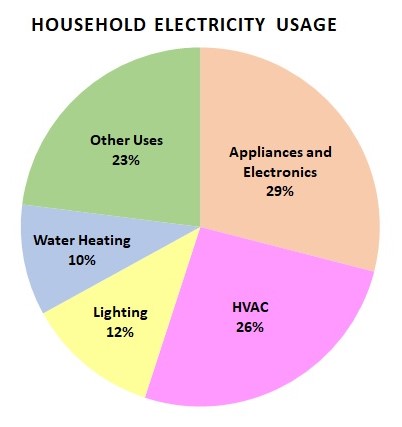Tips to reduce your electricity usage

Source. U.S. Environmental Protection Agency Website
We use electricity every day in nearly every aspect of our home life, from heating and cooling our homes, to cooking, washing dishes, washing and drying clothes, watching TV, using our computers, and lighting our homes at night. Electricity makes our modern lives more convenient and comfortable, but at a cost. It is possible to reduce your electricity usage and associated bills by using electricity wisely. Below are a few tips that can help reduce your electricity usage, thereby lowering your monthly bills.
Click on each line to see additional information.
Heating & Cooling
One of the very best investments in energy efficiency is to purchase and install a programmable thermostat. These thermostats allow you to heat and cool your home based on whether you are home, away, awake or asleep. Rather than choosing one temperature setting for the entire day, programmable thermostats allow you to select different temperature settings for different time periods that you create. For instance, if no one is home during the day, in the winter, allow the indoor temp to be a few degrees cooler during the day, then switch to your normal preferred setting a half hour before you arrive home.
Allowing the sun to shine inside your house during the winter can help heat your house. But allowing it to shine in during the summer can raise your indoor temp, causing your air conditioner to run excessively. Install blinds so that you can control whether the sun shines in or not to help heat and cool your house.
Once per year, have a licensed professional check over your heating and cooling system to make certain it is functioning properly and running at maximum efficiency. Also, make certain your indoor filter is changed regularly allowing your system to operate efficiently.
In the winter, air leaks can allow cold air in and your heated air out. In the summer, this is reversed. A simple way to find air leaks is to hold a smoldering incense stick near door and window edges to see if the rising smoke is disturbed. When leaks are found, seal them with caulk or weather stripping.
Glass is one of the worst insulators in your home. For older windows, adding extra sealing around your windows, such as storm windows or plastic sheeting, can add an extra insulating barrier to these poorly insulated areas.
Water Heating
Your water heater’s job is to maintain the temperature of the water inside it to the setting on its thermostat. If the hot water out of your faucet is so hot you cannot hold your hand under the faucet, you may need to consider lowering the temperature on the thermostat. The recommended minimum water temperature out of the faucet is 120 degrees.
Adding an insulation blanket to the exterior of your water heater can help it maintain the water temp, lessening the need for the water heater to reheat the water as often.
Most top-loading clothes washers use between 27-40 gallons of water per cycle. If you’re washing and rinsing using hot water, you’re using a lot of energy to create the hot water. It’s much less expensive to wash and rinse with cold water if it produces acceptable results. Some newer detergents are designed to work satisfactorily with cold water.
Long, hot showers use lots of hot water, requiring your water heater to use energy to create new hot water. Shortening your showers, or installing a flow control valve limiting the flow of water, can reduce the amount of hot water used for each shower.
Dishwaster drying cycles use a heating element to dry dishes. Any heating element uses a lot of electricity to create heat. When the wash cycle finishes, shut your dishwasher off and either open the door, allowing the dishes to air dry, or dry them with a towel. Also, maximize your energy usage by only washing full loads.
Cooking
When cooking on the stove top, use a pot just large enough for the job, and match it to an appropriately sized burner.
By keeping lids on pots and pans, cooking heat is retained in the pot or pan, requiring less energy for cooking.
Ovens work by heating the air inside the oven which then cooks the food. It takes much less energy to heat the smaller volume of air inside a toaster oven. Use a toaster oven to bake smaller items.
Lighting
Replacing older incandescent bulbs with newer compact fluorescent bulbs (CFL) or LED bulbs can reduce power consumption 70% or greater.
Turn off interior lights when they are not in use. If exterior lights stay on for long periods of time, use the lowest wattage bulb that provides acceptable lighting.
Miscellaneous
When replacing any appliance, always choose an Energy Star rated appliance. Also, compare the yellow Energyguide labels to assess estimated yearly operating costs.
When replacing your refrigerator, do not keep and use the old one. It is much better to buy a newer, larger refrigerator and keep all items requiring refrigeration in it. The same goes when replacing an older deep freeze.
Most newer entertainment devices use some power, even when off. This is known as a phantom load. To conserve energy, plug these devices into a power strip to be able to easily turn them all on and off as needed. This is also true for computers and related devices.
When using a clothes dryer, run the dryer the minimum amount of time required to dry the clothes. On newer models, use the auto-sensing cycle that automatically turns the dryer off when the clothes are dry. It is most efficient to immediately remove dried clothes and start the next load drying while the dryer is still hot.
For helpful videos regarding energy efficiency improvements you can make to your home, visit the TVA eScore video library by clicking
here.
